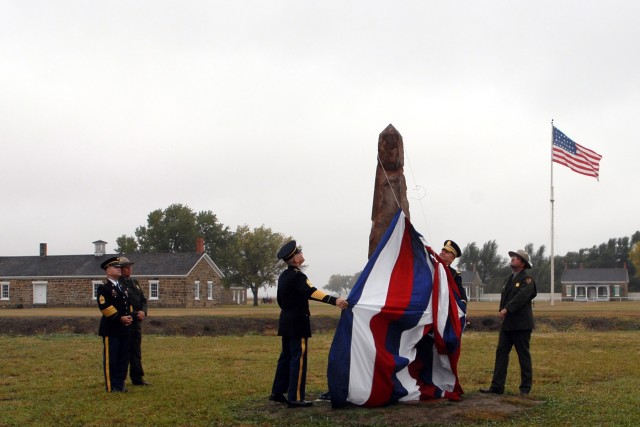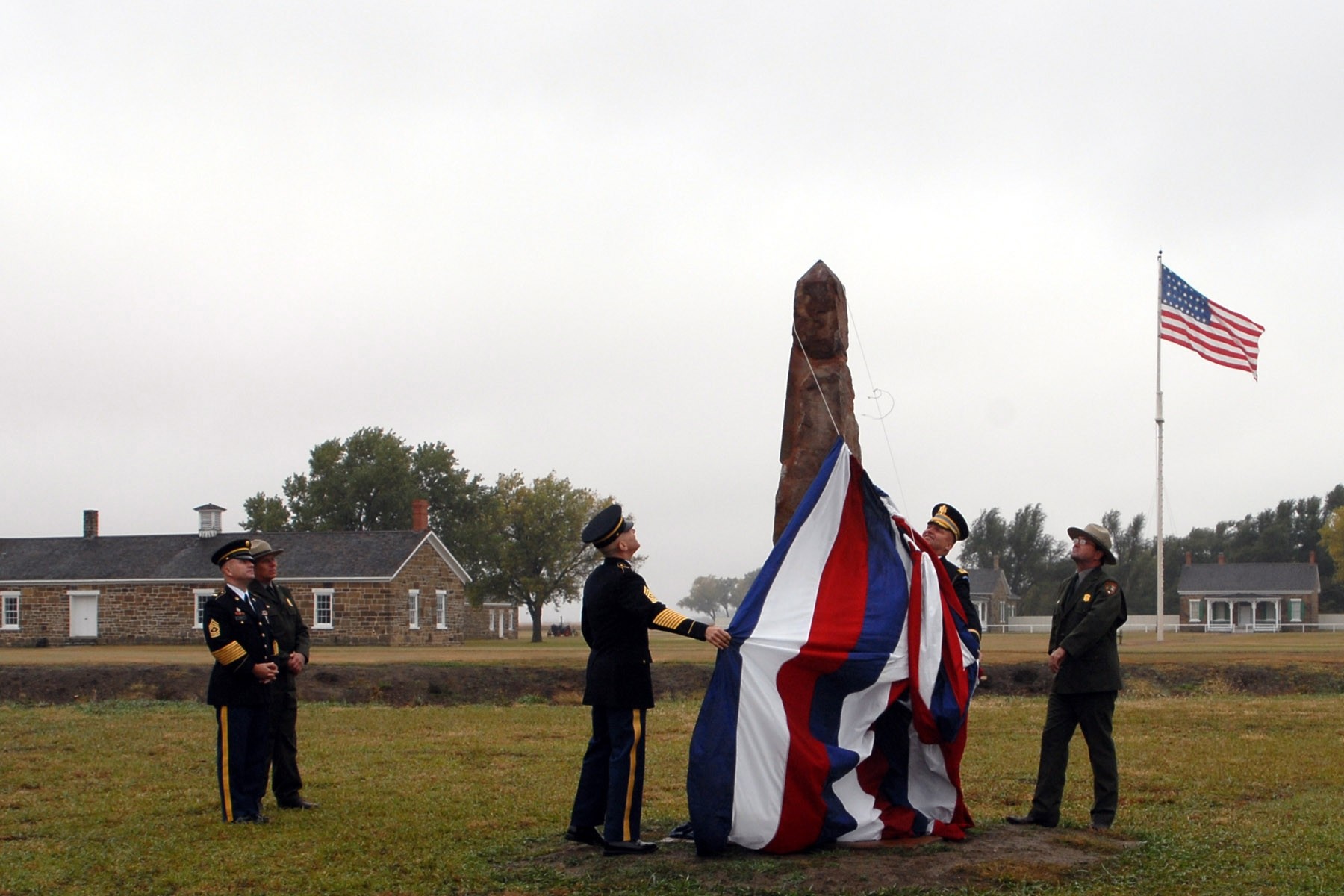As the oldest active infantry unit, the 3rd U.S. Infantry Regiment (The Old Guard) has been a witness to and an active participant in the development and defense of the United States. Created in 1784, just after the U.S. victory of the Revolutionary War, The Old Guard was formed to defend and expand a newly formed country.
The contributions of American Soldiers are easily identified in the wars they fought. Just as important, although too often overlooked, are the contributions frontier Soldiers made to develop the United States.
The Fort Larned National Historic Site near Larned, Kansas, is a fully preserved Army fort which pays tribute to the way of life and the accomplishments frontier Soldiers of the 19th century.
On October 11, the fort celebrated its 150th year by firing a 150-gun salute to the Soldiers who served there, hosting a lecture series about the life of a frontier Soldier, and rededicating a 3rd U.S. Infantry Regiment marker. Of all the units who served at Fort Larned, the 3rd U.S. Infantry Regiment (The Old Guard) was stationed there the longest.
In recognition of the contributions of Old Guard frontier Soldiers, the National Park Service invited Old Guard commander Col. David Anders and regimental command sergeant major Cmd. Sgt. Maj. David Martel, to tour the fort and to participate in the rededication of the 3rd U.S. Infantry marker at Fort Larned.
"What an honor it is to be asked to participate in this event with [the National Park Service]," said Anders. "The 150th anniversary of the establishment of Fort Larned is an event worth making. For me, the post represents American resolve at a time in our history when west-ward expansion was being challenged not only by Native American Indian tribes, but by the harshest of environmental and human living conditions."
The Old Guard Soldiers who were stationed at Fort Larned in the 1860s and 1870s were entrusted with an important mission, said Dr. Leo Oliva, a researcher and writer who focuses on the history of the Santa Fe Trail.
"From 1859 to 1878, the Army was charged with the protection of U.S. citizens," he said in a lecture about the history of Fort Larned. "Fort Larned was the most important outpost in the 1860s and 70s. The Soldiers provided protection for trail commerce, assistance in federal land surveys, and delegations for Indian treaties taking place at that time."
The job provided adventure for the Soldiers, but it was also a difficult life, said Dr. Rick Herrera, a historian with the Combat Studies Institute at the Combined Arms Center at Fort Leavenworth, Kansas.
"The average Soldier was 23 years old, and was in the Army because he was either on some hard luck, or he was adventurous," he said. "The life of a frontier Soldier was hard; death, discharge and desertion were too common. The Soldiers had poor basic skills, bad marksmanship, and little training."
Surviving in the unforgiving climates of the Plains was no easy task; it was made all the more difficult with the missions they were faced with, the clash of cultures and the lack of an outlet during leisure time, said Oliva. "The pay was low, and it was a monotonous life. Opportunities for leisure activities were limited."
In a guided tour of Fort Larned, Anders and Martel saw the way of life for an everyday frontier Soldier.
Anders remarked about what Fort Larned can tell Americans today about the frontier Soldier. "First and foremost I was extremely impressed by the preservation of Fort Larned. The Park Service has done an incredible job restoring this frontier post. It was actually the best-preserved frontier fort I've had the pleasure to visit. Having said that, these Soldiers did not live in the lap of luxury. Life on the frontier looked tough, secluded and monotonous."
Despite the dangers and challenges of protecting the frontier during the 19th century, the Soldiers of Fort Larned accomplished a tremendous mission: their efforts were essential in opening new opportunities for the American people. They developed resources which allowed the settlers to make the West a viable part of the republic, said Herrera.
The legacy the frontier Soldiers left behind in the American West speaks of how the American Soldier developed to become the finest fighting force in the world. Today, 150 years later, the work the frontier Soldiers accomplished can be seen throughout the western United States in the people who continue to thrive there.
"The story of the 3rd U.S. Infantry at Fort Larned in the 1860s and 70s is part of the American story we celebrate today," said Anders. "Commitment, perseverance and courage undaunted help define the American persona for the entire world. By honoring the memory of members of the 3rd Infantry Regiment who served so many years ago, we remind ourselves that their struggle and hardships helped secure our future."
Since the 1870s, The Old Guard has transformed from a group of rowdy frontier Soldiers to an elite force based at Fort Myer, Va. The Soldiers of The Old Guard are known as the Face of the Army, representing Soldiers stationed around the world to dignitaries and international and national visitors to the U.S. capital. They have the solemn mission of rendering final honors in Arlington National Cemetery, and of guarding the Tomb of the Unknown Soldier there. They also remain tactically proficient, as they stand ready to defend the national capital region in the event of an emergency. As a deployable unit, the Old Guard currently has one company deployed in Iraq.


Social Sharing